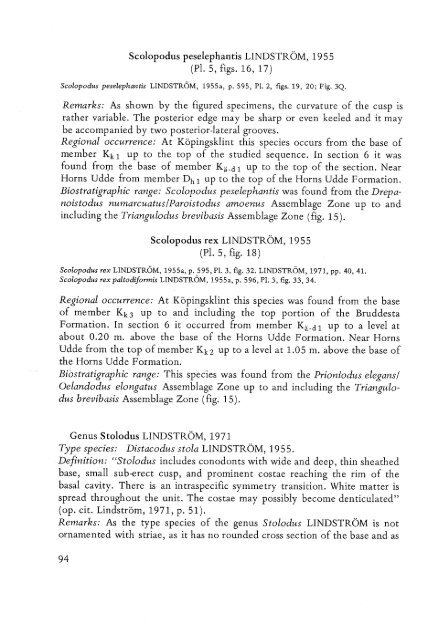UTRECHT MICROPALEONTOLOGICAL BUllETINS
UTRECHT MICROPALEONTOLOGICAL BUllETINS
UTRECHT MICROPALEONTOLOGICAL BUllETINS
You also want an ePaper? Increase the reach of your titles
YUMPU automatically turns print PDFs into web optimized ePapers that Google loves.
Scolopodus peselephantis LINDSTROM, 1955<br />
(PI. 5, figs. 16, 17)<br />
Remarks: As shown by the figured specimens, the curvature of the cusp is<br />
rather variable. The posterior edge may be sharp or even keeled and it may<br />
be accompanied by two posterior-lateral grooves.<br />
Regional occurrence: At Kopingsklint this species occurs from the base of<br />
member Kk 1 up to the top of the studied sequence. In section 6 it was<br />
found frol)1 the base of member Ka-d 1 up to the top of the section. Near<br />
Horns Udde from member D h 1 up to the top of the Horns Udde Formation.<br />
Biostratigraphic range: Scolopodus peselephantis was found from the Drepanoistodus<br />
numarcuatus/Paroistodus amoenus Assemblage Zone up to and<br />
including the Triangulodus brevibasis Assemblage Zone (fig. 15).<br />
Scolopodus rex LINDSTROM, 1955<br />
(PI. 5, fig. 18)<br />
Scolopodus rex LINDSTROM, 1955a, p. 595, PI. 3, fig. 32. LINDSTROM, 1971, pp. 40,41.<br />
Scolopodus rex paltodiformis LINDSTROM, 1955a, p. 596, PI. 3, fig. 33,34.<br />
Regional occurrence: At Kopingsklint this species was found from the base<br />
of member Kk 3 up to and including the top portion of the Bruddesta<br />
Formation. In section 6 it occurred from member Ka-d1 up to a level at<br />
about 0.20 m. above the base of the Horns Udde Formation. Near Horns<br />
Udde from the top of member Kk 2 up to a level at 1.05 m. above the base of<br />
the Horns Udde Formation.<br />
Biostratigraphic range: This species was found from the Prioniodus elegans/<br />
Oelandodus elongatus Assemblage Zone up to and including the Triangulodus<br />
brevibasis Assemblage Zone (fig. 15).<br />
Genus Stolodus LINDSTROM, 1971<br />
Type species: Distacodus stola LINDSTROM, 1955.<br />
Definition: "S'tolodus includes conodonts with wide and deep, thin sheathed<br />
base, small sub-erect cusp, and prominent costae reaching the rim of the<br />
basal cavity. There is an intraspecific symmetry transition. White matter is<br />
spread throughout the unit. The costae may possibly become denticulated"<br />
(op. cit. Lindstrom, 1971, p. 51).<br />
Remarks: As the type species of the genus Stolodus LINDSTROM is not<br />
ornamented with striae, as it has no rounded cross section of the base and as
















